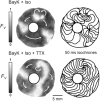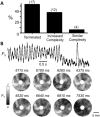Pro- and antiarrhythmic effects of ATP-sensitive potassium current activation on reentry during early afterdepolarization-mediated arrhythmias
- PMID: 23246594
- PMCID: PMC4285341
- DOI: 10.1016/j.hrthm.2012.12.017
Pro- and antiarrhythmic effects of ATP-sensitive potassium current activation on reentry during early afterdepolarization-mediated arrhythmias
Abstract
Background: Under conditions promoting early afterdepolarizations (EADs), ventricular tissue can become bi-excitable, that is, capable of wave propagation mediated by either the Na current (INa) or the L-type calcium current (ICa,L), raising the possibility that ICa,L-mediated reentry may contribute to polymorphic ventricular tachycardia (PVT) and torsades de pointes. ATP-sensitive K current (IKATP) activation suppresses EADs, but the effects on ICa,L-mediated reentry are unknown.
Objective: To investigate the effects of IKATP activation on ICa,L-mediated reentry.
Methods: We performed optical voltage mapping in cultured neonatal rat ventricular myocyte monolayers exposed to BayK8644 and isoproterenol. The effects of pharmacologically activating IKATP with pinacidil were analyzed.
Results: In 13 monolayers with anatomic ICa,L-mediated reentry around a central obstacle, pinacidil (50 μM) converted ICa,L-mediated reentry to INa-mediated reentry. In 33 monolayers with functional ICa,L-mediated reentry (spiral waves), pinacidil terminated reentry in 17, converted reentry into more complex INa-mediated reentry resembling fibrillation in 12, and had no effect in 4. In simulated 2-dimensional bi-excitable tissue in which ICa,L- and INa-mediated wave fronts coexisted, slow IKATP activation (over minutes) reliably terminated rotors but rapid IKATP activation (over seconds) often converted ICa,L-mediated reentry to INa-mediated reentry resembling fibrillation.
Conclusions: IKATP activation can have proarrhythmic effects on EAD-mediated arrhythmias if ICa,L-mediated reentry is present.
Published by Elsevier Inc.
Figures








Comment in
-
Whirling dervishes from Pinacidil to pinwheels.Heart Rhythm. 2013 Apr;10(4):583-4. doi: 10.1016/j.hrthm.2013.01.009. Epub 2013 Jan 11. Heart Rhythm. 2013. PMID: 23313872 No abstract available.
Similar articles
-
Bi-stable wave propagation and early afterdepolarization-mediated cardiac arrhythmias.Heart Rhythm. 2012 Jan;9(1):115-22. doi: 10.1016/j.hrthm.2011.08.014. Epub 2011 Aug 17. Heart Rhythm. 2012. PMID: 21855520 Free PMC article.
-
Optical mapping of drug-induced polymorphic arrhythmias and torsade de pointes in the isolated rabbit heart.J Am Coll Cardiol. 1997 Mar 15;29(4):831-42. doi: 10.1016/s0735-1097(96)00588-8. J Am Coll Cardiol. 1997. PMID: 9091531
-
[Ion channels and arrhythmias].Z Kardiol. 2000;89 Suppl 3:6-12. Z Kardiol. 2000. PMID: 10810780 German.
-
Symposium on the management of ventricular dysrhythmias. Concept of reentry versus automaticity.Am J Cardiol. 1984 Jul 30;54(2):1A-6A. doi: 10.1016/0002-9149(84)90810-5. Am J Cardiol. 1984. PMID: 6380258 Review.
-
Modulation of spiral wave reentry by K(+) channel blockade.Circ J. 2007;71 Suppl A:A26-31. doi: 10.1253/circj.71.a26. Circ J. 2007. PMID: 17587736 Review.
Cited by
-
Optimization of an In silico Cardiac Cell Model for Proarrhythmia Risk Assessment.Front Physiol. 2017 Aug 23;8:616. doi: 10.3389/fphys.2017.00616. eCollection 2017. Front Physiol. 2017. PMID: 28878692 Free PMC article.
-
Mechanisms of ventricular arrhythmias: from molecular fluctuations to electrical turbulence.Annu Rev Physiol. 2015;77:29-55. doi: 10.1146/annurev-physiol-021014-071622. Epub 2014 Oct 17. Annu Rev Physiol. 2015. PMID: 25340965 Free PMC article. Review.
-
Spontaneous initiation of premature ventricular complexes and arrhythmias in type 2 long QT syndrome.Am J Physiol Heart Circ Physiol. 2016 Dec 1;311(6):H1470-H1484. doi: 10.1152/ajpheart.00500.2016. Epub 2016 Oct 7. Am J Physiol Heart Circ Physiol. 2016. PMID: 27765749 Free PMC article.
-
Bistable spiral wave dynamics in electrically excitable media.Phys Rev E. 2023 Dec;108(6-1):064405. doi: 10.1103/PhysRevE.108.064405. Phys Rev E. 2023. PMID: 38243532 Free PMC article.
-
Perspective: a dynamics-based classification of ventricular arrhythmias.J Mol Cell Cardiol. 2015 May;82:136-52. doi: 10.1016/j.yjmcc.2015.02.017. Epub 2015 Mar 11. J Mol Cell Cardiol. 2015. PMID: 25769672 Free PMC article. Review.
References
-
- Fish FA, Prakash C, Roden DM. Suppression of repolarization-related arrhythmias in vitro and in vivo by low-dose potassium channel activators. Circ Res. 1990;82:1362–1369. - PubMed
-
- Spinelli W, Sorota S, Siegal M, et al. Antiarrhythmic actions of the ATP-regulated K current activated by pinacidil. Circ Res. 1991;68:1127–1137. - PubMed
-
- Carlsson L, Abrahamsson C, Drews L, et al. Antiarrhythmic effects of potassium channel openers in rhythm abnormalities related to delayed repolarization. Circulation. 1992;85:1491–1500. - PubMed
-
- Sato T, Hata Y, Yamamoto M, Morita H, et al. Early afterdepolarization abolished by potassium channel opener in a patient with idiopathic long QT syndrome. J Cardiovasc Electrophysiol. 1995;6:279–282. - PubMed
Publication types
MeSH terms
Substances
Grants and funding
LinkOut - more resources
Full Text Sources
Other Literature Sources
Medical
Miscellaneous

